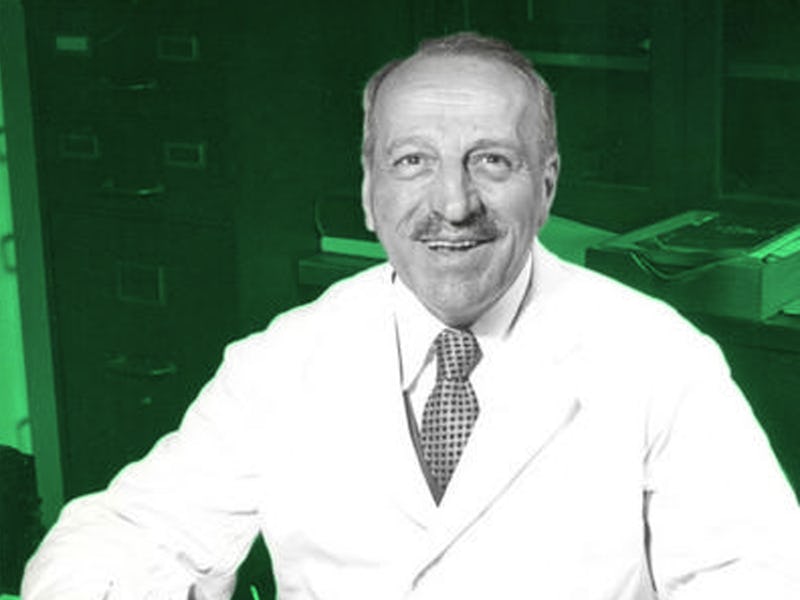Why Georgios Papanikolaou Never Clinched a Nobel Prize After 18 Nominations
The near misses were a "a matter of bad luck and definitely not a matter of failure."

In Monday’s Google Doodle, Georgios Papanikolaou, the inventor of the pap smear, is finally getting the attention he deserves. Public health organizations still swear by the pap smear as one of the best early detection methods for cervical cancer, but in his time, Papanikolaou was unable to convince the Nobel Committee that his findings deserved one of the highest awards in science.
The pap smear, which is widely used today, helps detect early signs of cervical cancer by analyzing changes in cells taken from a woman’s cervix (though a men’s version exists too, and is used to test for anal cancer). Before the broad acceptance of the pap smear, cervical cancer was still a leading killer of women. But between 1955 and 1992, rates of cervical cancer deaths declined by 60 percent, largely due to the test, according to the National Institutes of Health.
"It was as a matter of bad luck and definitely not a matter of failure."
Because of the impact of his work, Papanikolaou was nominated for the Nobel Prize in Medicine and Physiology 18 times in four separate years: 1948, 1949, 1951, 1953, and again, for an unlisted number of times in 1959 (his name is spelled “Papanicolaou” in the Nobel archive). Each time, he lost out. In an interview published in Experimental and Therapeutic Medicine, his student Neda Voutsa-Perdiki, former Director of Exfoliative Cytology at the University of Florida, noted that Papanikolaou’s near misses were “a matter of bad luck and definitely not a matter of failure.”
“A Matter of Bad Luck”
Papanikolaou’s first missed chance at a Nobel is, in retrospect, one of the most frustrating. In 1948, he was nominated twice for his “development of cytologic method for the detection of uteral cancer.” At first, his method was met with skepticism from the medical community when he unveiled it in 1928. In the Forties, his work was still new, but it began to gain crucial ground, culminating with his first shot at the Nobel.
A micrograph of a Pap test.
Ultimately, the prize went to Paul Hermann Müller, a Swiss chemist who won the Nobel Prize in Medicine or Physiology “for his discovery of the high efficiency of DDT as a contact poison against several arthropods.” DDT was used back then to kill mosquitos (which admittedly helped curb the spread of yellow fever and malaria). But DDT turned out to be a harmful environmental toxin that drove the bald eagle to the edge of extinction. It was ultimately banned in the United States in 1972.
After that unfortunate miss, Papanikolaou was awarded the 1950 Albert Lasker Clinical Research Award and got more chances at the Nobel, though each time he faced off against some incredibly worthy candidates. In 1953 he lost to Hans Adolf Krebs and Fritz Albert Lipmann, the co-discoverers of the Krebs Cycle, and Max Theiler, who won in 1951 for his work on a vaccine for yellow fever.
His Final Close Call
Papanikolaou’s last Nobel nomination was likely his closest call and his most devastating. In 1959, he was nominated again for the prize, but because records are not digitized past 1953, there isn’t a record of that nomination in the Nobel Prize archive. However, Voutsa-Perdiki, who was working in Papanikolaou’s lab at Cornell at the time, described it in detail, adding that a last-minute death of one of his supporters may have robbed Papanikolaou of the honor.
He came close to receiving the prize; however, the person, who supported Dr Papanicolaou’s nomination for the Nobel Prize, died. This person was Professor Axel Westman, Professor of Obstetrics and Gynaecology at the Karolinska Institute in Sweden. Thus, Dr Papanicolaou lost his principal supporter before the final decision; he was extremely unlucky.
It’s hard to say whether Papanikolaou would have clinched the award in 1959 if all had gone according to plan. But ultimately, the prize was awarded to Severo Ochoa and Arthur Kornberg, who shared the prize for their discover of how the body synthesizes DNA and RNA. Papanikolaou, notes Voutsa-Perdicki, “did not express any disappointment or dissatisfaction.” Papanikolaou died in 1962, having never clinched the prize for himself.
As far as consolation prizes go, over the course of his career, Papanikolaou did better than most. The pap smear has saved thousands of lives, and all together, that’s worth far more than even 18 Nobel nominations combined. On Monday, he would have turned 136.